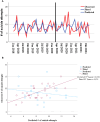Psychological distress among individuals with a suicide attempt or suicidal ideation and suicide attempts patterns: first two years of the pandemic
- PMID: 38544853
- PMCID: PMC10966906
- DOI: 10.3389/fpsyt.2024.1366191
Psychological distress among individuals with a suicide attempt or suicidal ideation and suicide attempts patterns: first two years of the pandemic
Abstract
Background: The COVID-19 pandemic and related restrictions may have led to increased stress, particularly in people with mental health problems. Since stress factors play important role in the emergence of suicide attempts (SA) and suicidal ideation (SI), they may have been exacerbated by the pandemic, which could have led to an increased number of suicide attempts. Thus, we first investigated whether the pandemic affected personal stress experiences and appraisal of coping potential in individuals with and without SA and SI. In a second step, we analyzed the frequency and dynamics of SAs by patients admitted to a psychiatric university clinic over a period of four years.
Methods: We examined stress experiences and appraisal of coping resources of inpatients recruited between March 2021 and February 2022 with SA (n=38), SI (n=27), and with mood disorder without SA or SI (n=45). In the second study, we investigated the time course of prospectively recorded patients with a suicide attempt (n=399) between January 1st 2018 and December 31st 2021 using interrupted time-series Poisson regression models.
Results: There was a significant main effect of group (F[2,107]=6.58, p=0.002) regarding psychological stress levels, which was significantly higher in the SA and SI groups than in the psychiatric control group. No significant differences were found in the appraisal of coping resources or in the frequency of SAs before and during pandemic. However, the pandemic had a significant impact on the seasonal pattern of SAs.
Conclusions: The pandemic increased psychological stress levels in individuals with SA and SI, which may be related to SI and do not necessarily result in SA. The pandemic did not affect the overall frequency of SA between March 2020 and December 2021, but interfered with the seasonal pattern of SA occurrence. Effective intervention strategies during a pandemic should include programs to strengthen the psychological resilience of people who are susceptible to mental health problems.
Keywords: COVID-19; coping resources; interrupted time series analysis; mental health; psychological stress; suicidal ideation; suicide; suicide attempts.
Copyright © 2024 Groh, Bahlmann, Colic, Schulz, Kastner, Polzer, Walter, Sobanski and Wagner.
Conflict of interest statement
The authors declare that the research was conducted in the absence of any commercial or financial relationships that could be construed as a potential conflict of interest. The author(s) declared that they were an editorial board member of Frontiers, at the time of submission. This had no impact on the peer review process and the final decision.
Figures



References
-
- Organization WH . Listings of WHO´s response to COVID-19 2020, June 29. Available online at: https://www.who.int/news/item/29-06-2020-covidtimeline.
LinkOut - more resources
Full Text Sources

